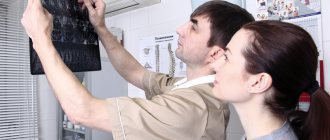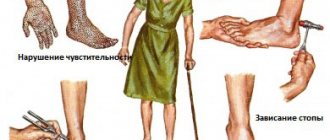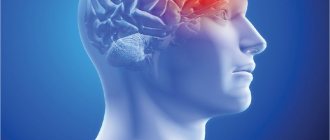Polyneuritis is a serious and dangerous disease associated with damage to the peripheral nervous system. The pathology is multiple and extensive. Polyneuritis is accompanied by multiple paresis, muscle weakness, decreased functionality and sensitivity of the limbs. With the acute nature of the disease, polyneuritis can become complicated. Inflammatory processes that have spread to the central nervous system significantly worsen the patient’s well-being.
Content:
- How it manifests itself
- Why does the disease occur?
- Treatment for polyneuritis is mandatory
- Effect on mental activity
- How doctors fight polyneuritis
Approximately 10% of people suffering from alcohol dependence have alcoholic polyneuritis.
This is an insidious disease in which the sensitivity of the limbs is greatly reduced, and some reflexes responsible for movement are completely blocked. The pathology is caused by regular intake of increased doses of alcohol.
As you know, ethanol makes the stable functioning of the central and peripheral nervous systems impossible. When examining alcohol addicts with this disease, neurologists identify disturbances in the functioning of the spinal cord and brain
, damage to cranial and spinal nerve endings.
If symptoms of alcoholic polyneuritis of the lower extremities appear, it is important to immediately obtain qualified medical assistance. If the patient tries to ignore the ailments that arise, the situation will only get worse.
Prevention of polyneuritis
Polyneuritis, the symptoms and treatments of which are described above, can be prevented. To reduce the likelihood of developing the disease, the following recommendations must be followed:
- Healthy food;
- prevent the development of hypovitaminosis;
- engage in the prevention of viral diseases during the epidemic season;
- walk more, play sports;
- If possible, avoid getting into stressful situations;
- strengthen the body's immune defense, engage in hardening.
Health to you!
How it manifests itself
At the first stage, the disease has a “erased” course. Almost nothing bothers the drinker. Only from time to time does he encounter the uncomfortable feeling of “goosebumps” running through his body. It becomes stronger if the patient sits in an uncomfortable position for a long time. After about an hour, the discomfort completely disappears.
After a few weeks, low muscle tone becomes noticeable
. This means that it is difficult for a person to perform any physical work. His arms and legs are too weak for this. To increase muscle tone, an alcohol addict can perform self-massage.
The danger of alcoholic polyneuritis is that it causes atrophy of the calf muscles. The skin of the extremities takes on an unhealthy bluish tint
, dries out, begins to peel off. These symptoms indicate the presence of cyanosis, a condition associated with elevated levels of carboxyhemoglobin in the blood.
Progressive alcoholic polyneuritis is also indicated by:
- separation of the nail plates;
- hair loss on the calves;
- the formation of non-healing ulcers on the legs;
- increased sweating;
- constantly freezing feet;
- pain in the lower extremities.
If treatment for alcoholic polyneuritis is not started at this stage, abnormal processes will spread to the upper limbs
. Then many nerves will be affected. The patient will no longer be able to fully control his own body. Persistent muscle weakness will force him to give up any activity and constantly remain in bed.
Other possible consequences of advanced alcoholic polyneuritis include:
- loss of basic neurological reflexes;
- "cocktail" gait (raising one leg too much while walking);
- disability.
Reasons for development
You don't need to be a scientist to understand that the cause of alcoholic polyneuritis lies in excessive consumption of alcohol-containing drinks. In alcohol addicts, metabolic processes are disrupted, there is a deficiency of B vitamins, and the central nervous system does not function properly. All these are factors that create conditions for the onset and progression of the disease.
Alcohol breakdown products are poisonous. These are toxic poisons. They reduce the conductivity of nerve fibers. The situation is aggravated if a person is accustomed to drinking low-quality alcohol or its substitutes. Then full functioning of the liver becomes impossible. The organ does not have time to neutralize toxic components absorbed into the blood of the drinker.
It’s good that polyneuritis of the extremities does not occur unexpectedly. This is not a disease that develops overnight. It is preceded by a fairly long period of persisting painful symptoms. Therefore, if the addict is attentive to his physical condition, he will be able to understand that something strange is happening to his muscles. Then he will have time to see a doctor before it is no longer possible to reverse the disease.
Why does the disease occur?
Due to alcohol dependence, many metabolic processes that occur normally in the body of every person become impossible. There is a deficiency of B vitamins, which play a decisive role in the functioning of the nervous system. Due to these changes, conditions are created for disruption of nerve conduction, followed by alcoholic polyneuritis.
The situation is aggravated by the fact that alcohol metabolites are poisons. They change the conductivity of nerve fibers and poison the liver. The latter at some point ceases to cope with the increased ethanol attack. Then the level of toxins in the blood increases sharply.
Alcoholic polyneuritis is very dangerous
. The only good thing is that it never arises unexpectedly. Before serious symptoms appear, the patient will encounter “precursors”. It is important not to miss them. Then it will be possible to reverse the disease.
Causes and symptoms of polyneuritis (polyneuropathy)
There is a certain range of reasons that can cause polyneuropathy (polyneuropathy, polyradiculopathy) and polyneuritis (neuritis, radiculoneuritis, radiculitis, polyradiculoneuritis):
- Metabolic disorders . The tissue of the nervous system is very demanding in terms of providing it with nutrients. The slightest deficiency can lead to disruption of nerve function and even death of nerve fibers. Most often we find two types of polyneuropathy: diabetic polyneuropathy, polyneuropathy due to disease of the thyroid and other glands.
- Infectious inflammation in various neuroinfections . Most often, this is inflammation of the peripheral nerves with the herpes zoster virus (Herpes Zoster, Varicella Zoster), neuroborreliosis.
- Autoimmune inflammation of the nerves , i.e. aggression of the immune system towards the tissue of the nervous system. It occurs due to a genetic predisposition and is often triggered by infection and chronic stress. The immune system recognizes peripheral nerve tissue as foreign and attacks and destroys it. Typical cases of autoimmune polyneuropathy: CIDP demyelinating polyneuropathy, Guillain-Barré polyneuropathy, polyneuropathy in rheumatic diseases, viral hepatitis, polyneuropathy in sarcoidosis.
- Toxic damage to peripheral nerves. The tissue of the nervous system is sensitive to various toxins (poisons). These can be solvents, paints and varnishes, metals, household poisons, narcotic substances, etc. Most often we detect Alcoholic polyneuropathy.
Possible symptoms (polyneuritis, radiculopathy, polyradiculoneuritis, polyneuropathy and other diseases of this group):
- Numbness and decreased sensitivity, usually starting in the hands and/or feet (like “gloves” and “socks”), may spread upward;
- Increased sensitivity (tactile, temperature, etc.), starting, as a rule, in the hands and/or feet (like “gloves” and “socks”), may spread upward;
- Muscle weakness (paralysis, paresis), usually starting in the hands and/or feet, spreading upward;
- Impaired vision, hearing, and smell due to disruption of the conduction of excitation along the visual, auditory nerves and olfactory tract;
- Impaired balance and coordination, unsteadiness, dizziness due to a deficiency of signals entering the brain from sensory receptors;
- Pain along the nerves when they are inflamed; when affected by the herpes virus, the pain is accompanied by skin rashes along the nerves;
- Skin rashes are usually a sign of infection by the herpes virus (Varicella-Zoster), painful blisters surrounded by an area of redness of the skin, which eventually open and form crusts;
- Violation of pelvic functions, i.e. bladder and bowel dysfunction due to lack of nervous system control;
- General malaise, fatigue, fever, depression, apathy.
If motor nerve fibers are damaged (they transmit commands from the brain to the body), then the functioning of muscles and other executive organs (for example, the bladder and intestines) may be disrupted.
If sensitive nerve fibers are damaged (they transmit information from the sensitive receptors of the body to the brain), then a decrease or distortion of sensitivity (skin sensitivity, vision, hearing, smell, joint-muscular sense) is possible.
Treatment for polyneuritis is mandatory
There are several types of polyneuritis, but alcoholic is the most dangerous. The pathology disrupts the functioning of the arms and legs. Because of it, the addict cannot control his body and becomes disabled.
If the vagus nerve is damaged, the limbs lose sensitivity for a long time. A feeling of lack of air and tachycardia make themselves felt. Even the patient’s own fingers stop obeying him. Any actions related to fine motor skills become impossible
.
It gets to the point where an alcohol addict cannot chew and swallow food, talk, smile, walk, or control the urge to go to the toilet. His nervous system works uncoordinated. In severe cases, alcohol dependent polyneuritis turns into Korsakoff syndrome, characterized by:
- partial amnesia;
- disorientation in the surrounding space and time;
- hallucinations;
- uncontrollable and unreasonable fear;
- panic attacks;
- depressed mood.
Quite often, alcoholics do not understand the full danger of the situation in which they find themselves. They are convinced that everything is fine with them. They believe that relatives and doctors are simply trying to scare them. This attitude does not bring anything good. After all, the longer treatment is delayed, the more dangerous the consequences of polyneuritis.
Why is alcoholic polyneuritis so dangerous?
There are many types of polyneuritis, but the alcoholic type of the disease is considered the most dangerous. This is due to the fact that the disease affects the upper and lower limbs, makes a person disabled, and deprives him of the ability to control his own body.
If the work of both arms and legs is disrupted, the vagus nerve is damaged. Then the person feels that his limbs often and for a long time lose sensitivity. From time to time he experiences shortness of breath and his heart rate increases. Finger motor skills are rapidly deteriorating.
In the absence of proper treatment, the drinker will soon no longer be able to independently get up from a lying/sitting position, talk, chew and swallow food, or control the process of urination. The damage also affects his brain - creating the preconditions for the occurrence of Korsakoff's syndrome.
The latter is characterized by:
- memory loss, inability to remember and reproduce information;
- difficulties with orientation in space;
- disorientation in time;
- hallucinations, inventing non-existent events;
- panic attacks;
- causeless fear;
- frequent mood swings.
Alcoholics who have alcoholic polyneuritis combined with Korsakoff's syndrome often do not realize that they are seriously ill. They deny that they have mental problems. Treating such people is always difficult. It is also difficult to live with them in the same apartment.
Effect on mental activity
The disease not only impairs the motor functions of the alcohol addict, but also changes the functioning of the brain. Such patients fantasize a lot and invent all sorts of fables. At the same time, they sincerely believe that they are telling about real events.
They see non-existent images and hear imaginary voices. Such changes contribute to personal degradation and deprive a person of the skill of adaptation in non-standard situations.
Features of treatment
Knowing about the dangerous consequences of the disorder, there is no need to talk about its home treatment. First you need to conduct a comprehensive examination. It will allow us to establish what is the true cause of the disease. Very often it turns out that polyneuritis arose not only due to alcoholism, but also due to some kind of concomitant pathology. Then therapy should be aimed at eliminating these two factors at once.
A prerequisite for successful treatment is complete abstinence from alcohol. If this is not done, even the most effective medications will not provide positive dynamics.
It is easiest to cure the disease in its first stages. Typically, therapy includes the following stages:
- Relieving craving for alcoholic drinks. For this purpose, cleansing procedures are carried out - the patient is given a drip, with the help of which the blood is quickly cleansed of toxic metabolites. The patient is then coded. The coding method is selected taking into account the characteristics of the health condition. In the presence of concomitant mental disorders, the optimal solution is psychotherapeutic coding. It does not involve the use of any medications, which means it eliminates the additional drug load on the drinker’s body.
- Undergoing physiotherapeutic procedures. Electrophoresis, reflexology, massage, therapeutic baths, exercise therapy - all these are measures to improve nerve conduction and increase sensitivity of the upper and lower extremities.
- Taking medications. Vitamin and mineral compounds, hormones, antihistamines, anti-inflammatory drugs, and analgesics help cope with the symptoms of alcoholic polyneuritis. Specific medications are always selected for the patient individually, as are their dosages.
- Diet. With the diagnosis described, it is important to eat right, eat more fruits and vegetables. Your diet should include dishes containing B vitamins.
It is important that the addict strictly follows all medical prescriptions and commits to leading a healthy lifestyle. Only then will he be able to recover.
How doctors fight polyneuritis
A person who knows what alcoholic polyneuritis leads to understands why it is not treated at home. Since the disease is very insidious, the patient must remain in the hospital throughout the entire therapeutic course.
To stop the progression of the disease and remove dangerous symptoms, it is imperative to give up alcohol. Otherwise, all treatment and rehabilitation measures will be meaningless.
Traditionally, the fight against polyneuritis in alcohol addicts includes the following stages :
- Detoxification procedures.
Needed to reduce the craving for alcohol-containing drinks. The addict is given IV drips and sorbents are prescribed. Due to this, alcohol is more quickly neutralized and removed from the body, and suitable conditions are created for the functioning of vital internal organs. - Physiotherapy.
Massage, intravenous laser blood purification, acupuncture, exercise therapy, electrophoresis are optimal helpers at any stage of polyneuritis of the upper and lower extremities. With their help, it is possible to improve nerve conduction and increase muscle tone in a short time. - Medication correction.
Typically, for alcoholic polyneuritis, anti-inflammatory, antihistamine, hormones, painkillers, vitamins and minerals are used. The doctor decides on an individual basis what medications the patient will need for a speedy recovery and in what dosages they will need to be taken. This is due to the fact that, despite the similar symptoms, in all patients the disease occurs with certain characteristics. The latter must be taken into account when drawing up a correction scheme.
For a speedy recovery, it is very important to eat a balanced diet and perform physical therapy. You need to eat as many fresh vegetables and fruits as possible, foods containing high amounts of B vitamins.
Polyneuritis: symptoms
Clinical manifestations of the disease depend on the location of the pathological process and the severity of polyneuritis. The main symptoms of this pathology are:
- gradual onset (except in cases where there is acute intoxication of the body);
- damage initially to the lower extremities, starting with the feet;
- decreased sensitivity of fingers;
- gait instability, which is a consequence of foot damage;
- “cock” gait – the patient bends his legs at the knees and raises them high;
- feeling of tingling, goosebumps, numbness in the limbs;
- weakness of the hands - it becomes difficult for a person to perform the simplest actions (hold a pencil, tie shoelaces, fasten buttons, and so on);
- periodic severe pain in the limbs;
- decreased pain and temperature sensitivity;
- darkening and thinning of the skin, which occurs as a result of trophic disorders, brittle nails, and the formation of trophic ulcers.
As the disease progresses, sensory and motor disturbances increase and spread throughout the body. The patient cannot get up and stops caring for himself. This is especially often observed with alcoholic polyneuritis.
Literature:
- Zhirkova G.I. Alcoholic polyneuropathy (polyneuritis) and its reversibility during detoxification treatment. Abstract, dissertation for the degree of candidate of medical sciences. 14.0013. Orenburg State Medical Institute. - Orenburg, 1974. - 18 p.
- Kurashevich K. G. Diagnosis and treatment of early manifestations of nervous system damage in alcohol abusers. Dissertation of a candidate of medical sciences. 01/14/11. Place of defense: First St. Petersburg State Medical University named after. I. P. Pavlova. — St. Petersburg, 2021. — 48 p.
- Lee I.V. Evaluation of the effectiveness of using physiotherapy methods and justification of organizational and rehabilitation measures in the treatment of patients with alcoholic polyneuropathy. Dissertation of a candidate of medical sciences. 14.00.51. Place of protection: Center for Balneology and Rehabilitation. - Sochi, 2009. - 24 p.
Need some advice?
OR CALL A DOCTOR
CALL!
+7
Is it possible to do something on my own?
It is possible to cure polyneuritis on your own only if the following conditions are met:
- the patient is immediately coded;
- the drinker is highly motivated to recover;
- polyneuritis is at the very first stage and its symptoms are still barely noticeable.
Unfortunately, such situations are encountered very rarely in medical practice. Most often, alcohol addicts who are no longer able to control their arms and legs come to see a doctor. Such patients are immediately hospitalized in a hospital.


![Rice. 2. The role of vitamin B12 in the synthesis of the myelin sheath of nerve fibers [45] 2. The role of vitamin B12 in the synthesis of myelin sheath [45]](https://lovetherapy.ru/wp-content/uploads/ris-2-rol-vitamina-v12-v-sinteze-mielinovoj-obolochki-nervnyh-330x140.jpg)



